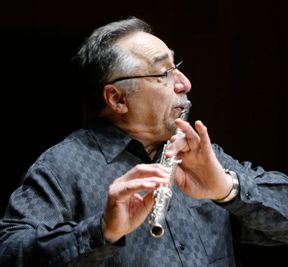 |
| Harvey Sollberger performs at JiB 2010 |
Sollberger's history with June in Buffalo extends back many years. He was one of the core group of composers who immediately lent their support when David Felder restarted the festival in 1986, and he has played a significant role ever since—both as a composer and a performer. In 1993, he conducted the June in Buffalo Chamber Ensemble while they performed his piece, The Advancing Moment, and in 1996 he conducted an early performance of Felder's Inner Sky. In 1998, he guest-conducted the New York New Music Ensemble in a program that included works by Davidovsky, Ken Ueno, and Christian Carey, and conducted the same ensemble the following year for a performance of Wuorinen's New York Notes (the program also featured Sollberger's flute/clarinet duet, To the Spirit Unappeased and Peregrine). Sollberger has premiered several important works at June in Buffalo, conducting the first performance of Roger Reynolds' On the Nature of Things in 1996, and David Felder's In Between in 2000 (with the JiB Chamber Orchestra). He has continued to be a reliable fount of exciting music throughout the 2000's: in 2006 he performed his flute solo Riding the Wind I, and performed the first in another series of flute works, New Millennium Memo I, at a special anniversary concert at JiB 2010. The week of this year's festival, Edge of the Center will publish an essay by Sollberger, called "Buffalo's Third Wave", celebrating the festival and its history.
Sollberger's most recent works, including Mural for piano four hands and Soli e Scherzi for flute and piano (both 2014), embrace a new formal strategy the composer calls "Field form." Put simply, these pieces are circular and "can be entered and left at many different points," allowing the performer to begin at any location, and continue through the material until they return to the point at which they began. Existing in such a "Mobius space" these works lack the traditional teleological markers 'beginning,' 'middle,' and 'end.' As the composer explains, "What's 'center' in one performance becomes 'edge' in another," (or conceivably, the 'edge of the center' in yet another). This seemingly simple formal strategy creates significant compositional challenges however, since while these pieces lack 'beginnings' and 'endings,' they are not without development. Sollberger still deftly crafts the moment-to-moment evolution of his material, aiming to compose music that has a gas-like evanescence, with "the potential to assume the many forms and shapes of a cloud."
For those who are familiar with the composer's earlier music, terms like "evanescent", and "gas-like" might not be the first terms that come to mind. At this year's June in Buffalo, NYNME will perform The Advancing Moment (1993), a piece which Jeremy Eichler of the New York Times described as featuring "tough, aggressive gestures," writing that the work "pitted groups of instruments against each other and built into a kind of pummeling fanfare, full of menacing extremes of pitch and volume." Fellow JiB faculty composer Roger Reynolds has written of Sollberger's "rhythmically craggy and motivically kaleidoscopic music of high expressive energy and gestural force." This is not just evident in the earlier, more "menacing" pieces, but also in his more recent work. Take, for example, New Millennium Memo II for solo flute (see above), in which the composer maintains the aforementioned 'expressive energy' and 'gestural force' through subtle shifts in timbral coloration, graceful developmental variations, and quick agile melodic fragments that are as rhythmically complex as they are effortlessly performed (by the composer himself). It is clear that Sollberger's style and technique is in a continuous state of evolution and reinvention, developing and varying in much the same way his musical material does.
Attendees of this year's festival will be treated not only to NYNME's adroit performance of The Advancing Moment, but also to a unique Harvey Sollberger solo recital at Pausa Art House. The event will feature the composer performing works for solo flute and solo accordion(!). Indeed, Sollberger recently returned to the accordion, an instrument he had once studied, but with which he hadn't worked closely since 1956. His accordion repertoire, however, doesn't feature the spiky modernism composed by himself and his contemporaries, instead leaning heavily on polkas, waltzes, folk tunes, and especially Neapolitan song repertoire. It is perhaps this recent addition to Sollberger's musical life, more than anything else, that presents the composer as an artist with the "potential to assume the many forms and shapes of a cloud." He embodies the idea of the music that forgets—not in the sense that he is stricken with any sort of musical amnesia (indeed, quite the opposite), but rather that he, throughout his career and continuing into the future, seems to be driven by a need to reinvent himself, sometimes obsessively—as he goes along.
—Ethan Hayden
*Sollberger, Harvey. "Essay Before a (Non-)Sonata" preface to Mural. (American Composers Alliance, 2014). (emphasis added).




